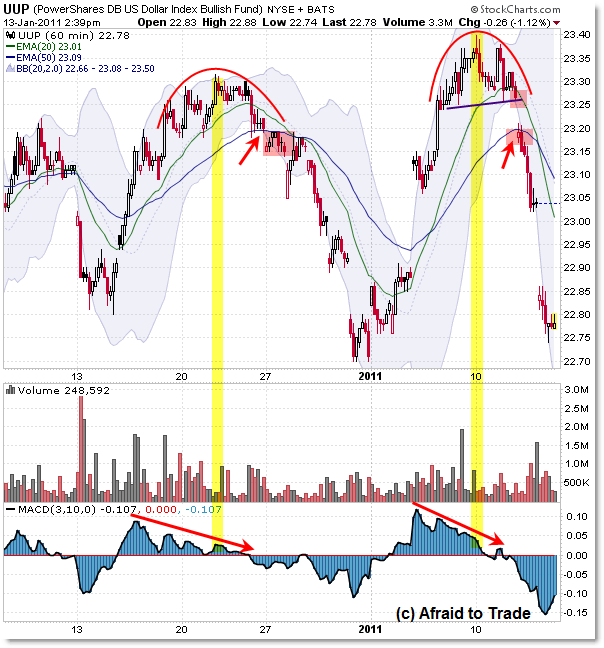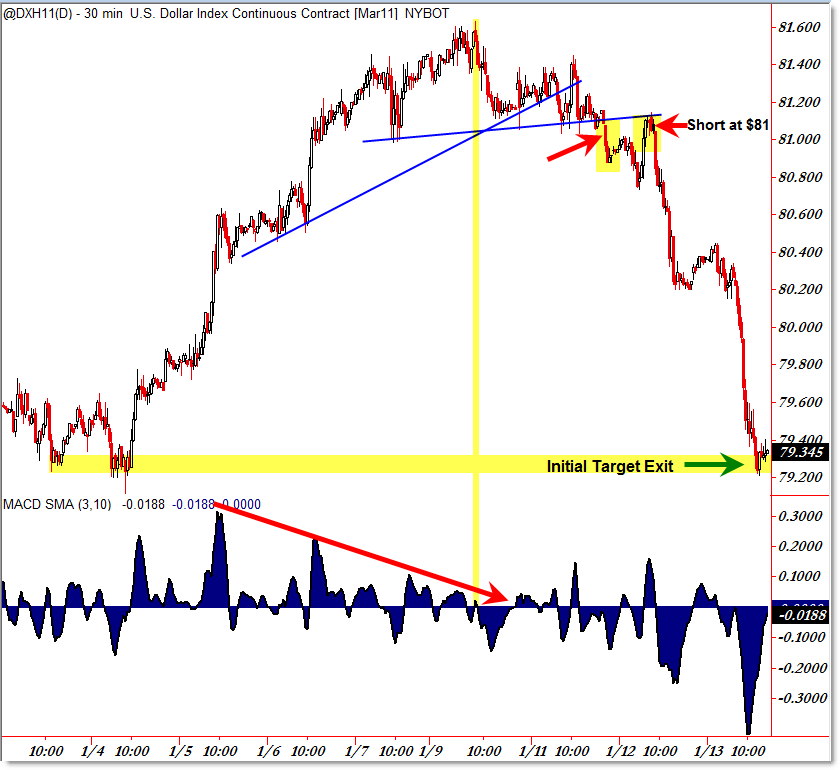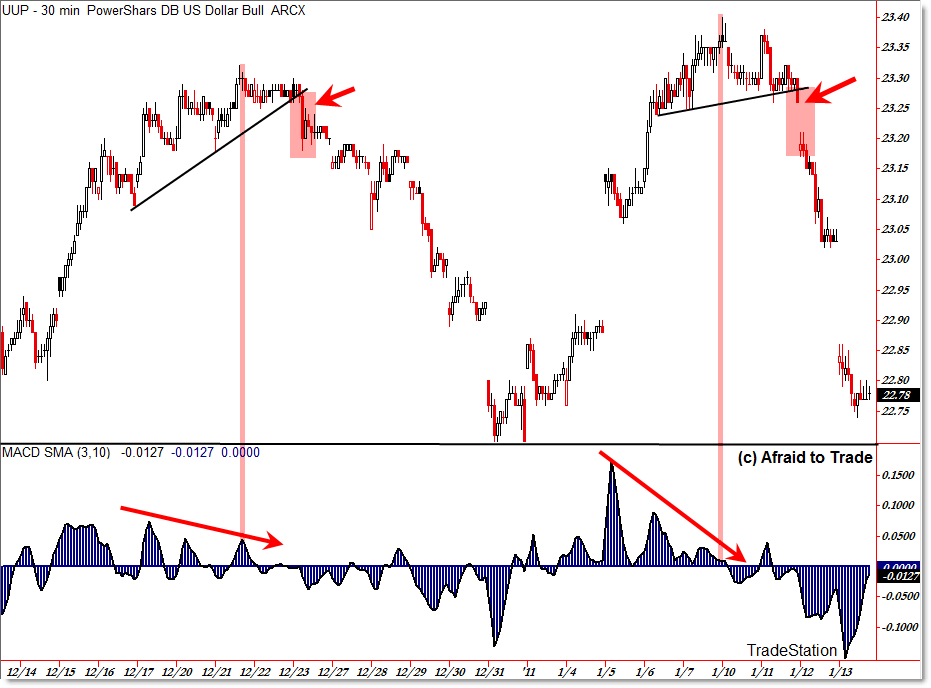A Lesson in Trading Intraday Arc Divergences with Dual Timeframes in UUP
I always like doing “Step-Inside” analysis with trades and price structure, especially when combined with a known reference level on the higher timeframes.
Let me walk you through a very good recent example of setting up and trading two specific high-probability, low-risk opportunities in the UUP – US Dollar Index EFT (lesson would be the same with the Dollar Futures Contract).
In fact, this type of lesson – divergences, arc patterns, and higher timeframe resistance – is just as applicable on any stock or market.
Let’s set the picture up first on the Daily Chart:

Since December, the Dollar Index – seen above using the ETF proxy UUP – has been in a sideways trading range with clearly defined price boundaries.
They’re roughly $81 (resistance) and $79 (support) in the Dollar Index, though that translates to around $23.30 (resistance) and $22.75 (support) in the UUP.
Keep in mind it’s the CONCEPT and not the price levels that are important in learning this lesson – the range would be much wider in a more volatile stock or market.
So cutting through all the noise, the MAIN IDEA as we slip down to the lower frames is that the $23.30/$23.50 level was a key price resistance level to watch as a known reference level (prior low and near the upper Bollinger Band).
With this in mind – resistance – let’s now step inside the intraday charts to determine where a specific intraday trade entry occurred (one which you could use leverage as necessary to compensate for the low price target 50 cents lower).
Let’s set-it up first on the 60-min chart:

This is a lesson on MULTI-SWING NEGATIVE MOMENTUM DIVERGENCES – so we use our trusty 3/10 Momentum Oscillator (change your MACD settings to 3, 10, 0 to replicate this indicator in StockCharts).
As price initially pushed higher near December 21st (first vertical line), we see that a Multi-Swing Negative Momentum Divergence formed in the oscillator – a great example.
Divergences are NON-CONFIRMATIONS that suggest a retracement or reversal in trend is a growing possibility, but only very aggressive traders walk up and put on a trade due solely to a divergence.
I recommend waiting for a signal from price, namely in the form of an official price breakdown of a short-term rising trendline or under a recent price low, or under a rising short-term moving average (such as the 20 or 50 as seen above).
With that, we have the following information or wind at our back:
1. Higher Timeframe Resistance Level at $23.30
2. Multi-Swing Negative Momentum Divergence (60-min)
3. Price officially breaking the rising 20 then 50 EMA and of course rising trendline
So, enter short when price confirms the divergence with a breakdown – such as the $23.20 level as highlighted, or even earlier on a breakdown of the rising trendline (we’ll see that shortly) and 20 EMA at$23.25.
Always place your stop just beyond the recent swing high that locked-in the divergence, keeping in mind the higher timeframe structure.
A stop at $23.50 seems logical, which gives a 25 cent stop for about a 50 cent target, namely the prior price swing low as seen from early December. That gives us a 2 to 1 reward to risk relationship (and a generous stop).
In the event you chose to place your stop directly above the swing high at $23.30 – let’s say $23.35 – then that enhances the reward/risk relationship to a 10 to 15 cent stop (depending on entry) for a 5 to 1 (risk 10 cents to make 50) reward to risk relationship.
As you see, the price ‘fell off a cliff’ and completed a reversal down fully to the target prior price low and actually exceeded it slightly – triggering your profitable exit at or just beyond your target (trust your targets!).
I won’t go into as much detail on the second, roughly identical structurally set-up that just triggered and hit its target today.
We had a similar price swing up to the higher timeframe resistance, a very similar multi-swing negative divergence, and a very similar structural price breakdown/confirmation which was actually more violent/rapid than the previous set-up.
This had entry on the gap down yesterday morning at $23.30, same target $22.75, and this trade met its objective even quicker.
Now, let’s take it one step beyond the charts and focus exclusively on price and momentum – and trendlines – to make this set-up even easier to understand and implement.
UUP 30-min:
(Click for full-size image via Flickr)
Looking just at price, trendlines, and the 3/10 Momentum Oscillator, you can see the clarified entries – including the recent ‘aftermath’ of the morning gap yesterday.
It’s a sub-lesson in price reversals after multi-swing divergences – sometimes they can be like breakout trades that don’t give you clean entries, but you have to trust the structure and opportunity, else you’ll feel you’re chasing the move and miss the opportunity.
It’s therefore so important to see many examples like this so that you build your experience and confidence so you can enter, manage, and exit appropriately the next time a similar set-up occurs.
And one last chart, stepping even closer inside the recent swing – this time using the @DX Futures Contract:

You’re probably more likely to trade the Dollar Index via the Futures or FOREX market (relative to other currencies) than the UUP intraday, so I wanted to give that perspective, yet still show the UUP for traders who don’t use futures.
Anyway – the recent sell set-up example above in the UUP that was a 50 cent move was roughly a $1.80 index move in the Dollar Index Futures Contract (from the $81 level to the $79.20 level), making the profit potential up to $1,800 per single contract, with a risk being the top of the swing high at$81.60 (risking about $600) for a good 3 to 1 reward to risk relationship.
For reference, a 10 cent move in the DX futures contract is $10 for your account per contract – the index moves in half-cent increments making it a good market for traders who want to learn futures to practice futures trading.
The main idea is that these salient concepts – higher timeframe resistance (or support in the opposite case) and lower timeframe multi-swing divergences are powerful combinations that often lead to low-risk, high probability opportunities in virtually any market and even timeframe (provided you combine a higher and a lower).
While it’s fun to discuss structure and set-ups, the money is made with execution tactics, and I’ll be doing a presentation soon at the New York Trader’s Expo – February 20 – 23 where I discuss specifics of “Trade Execution Tactics.”
I also have a whole chapter in the new Trading Course book dedicated to Edge, Expectancy, and Execution Tactics.
There’s still time to register for the entire free conference and I hope to see you there!
Corey Rosenbloom, CMT
Afraid to Trade.com
Follow Corey on Twitter: http://twitter.com/afraidtotrade
Order your copy of The Complete Trading Course (Wiley Finance) now available.


not able to duplicate MACD 3,10,0 on other software (TOS or freestockcharts.com) they don't like 0 macd length. could you help? thx.
Good question – the main idea is to eliminate the 'signal' line of the traditional MACD but that's ok if software doesn't allow. Try 3, 16, 1 which might work. Otherwise, the original 3/10 Oscillator used by Linda Raschke uses settings 3, 10, 16 (16 for the signal line). I just prefer to look at the EMA differential without a smoothing period.